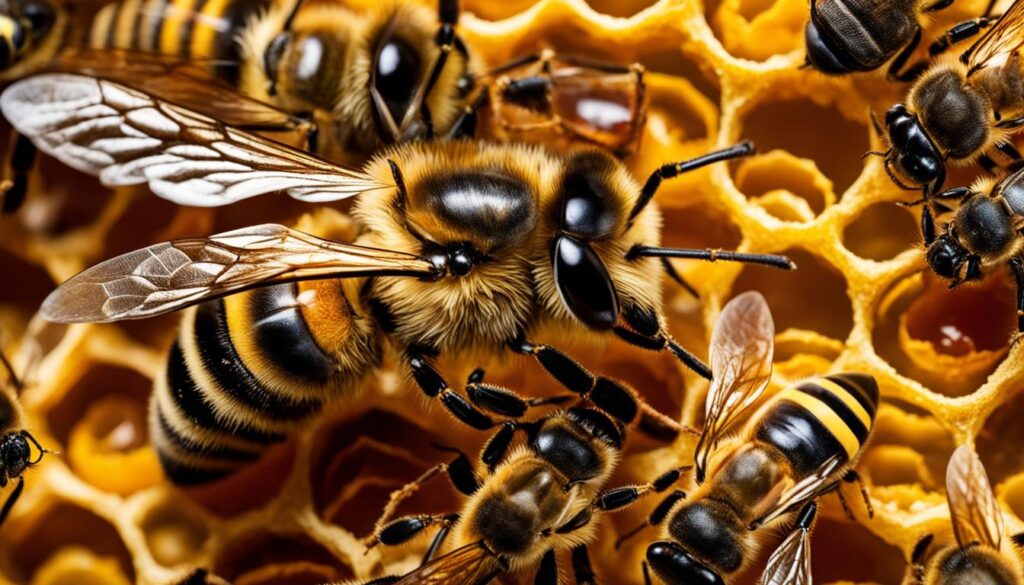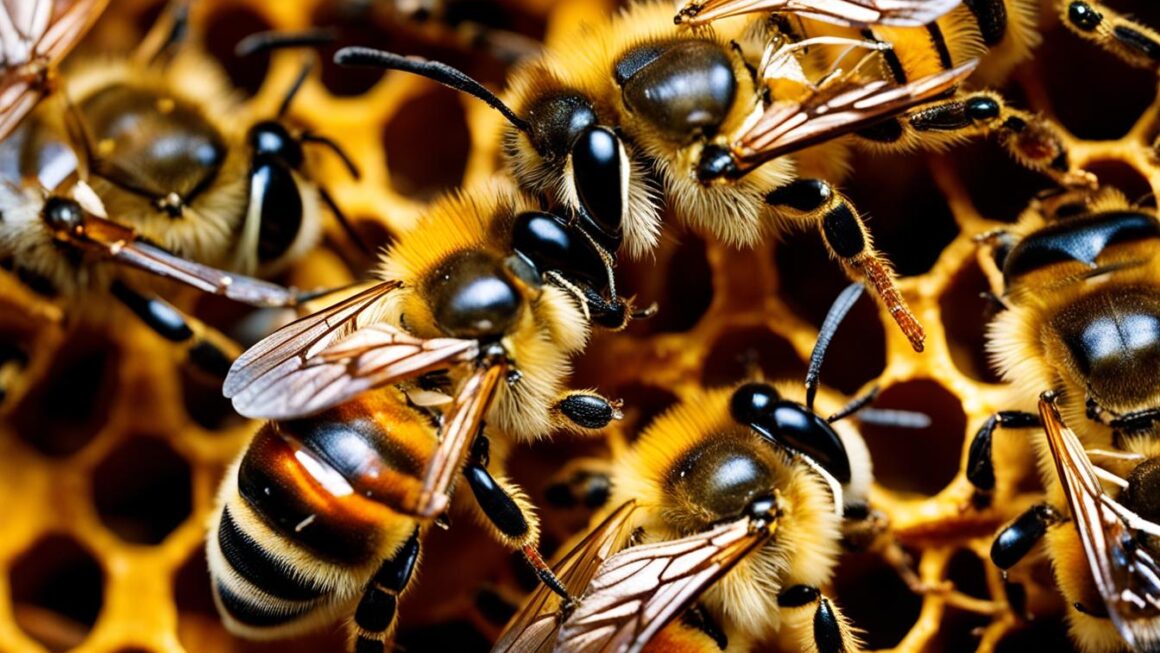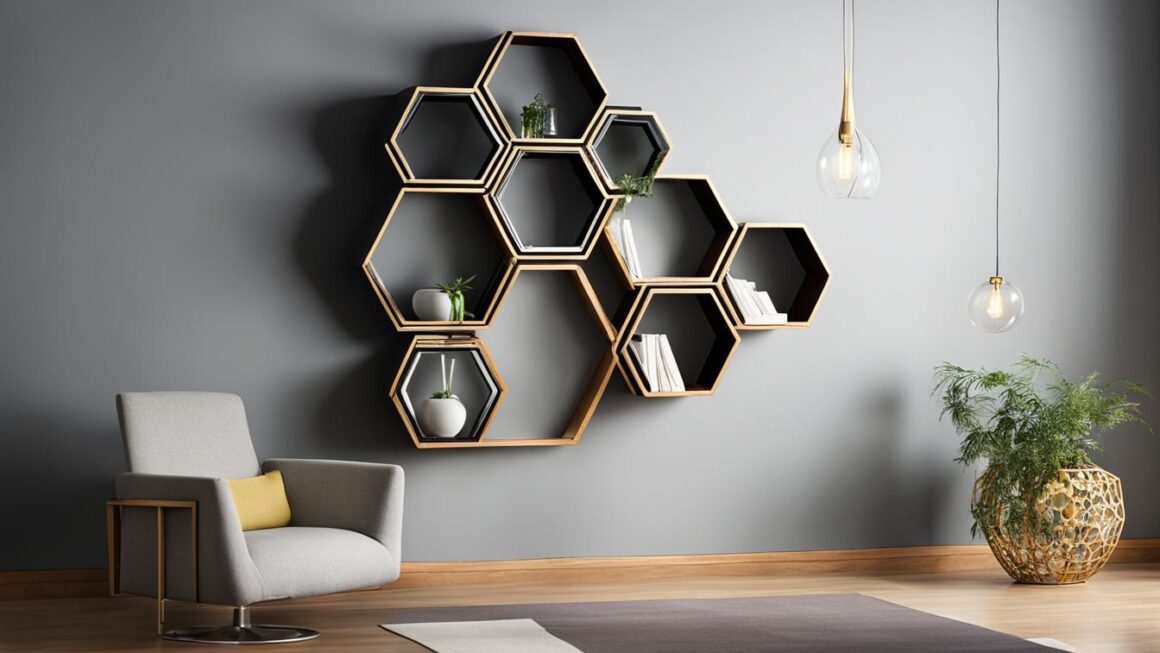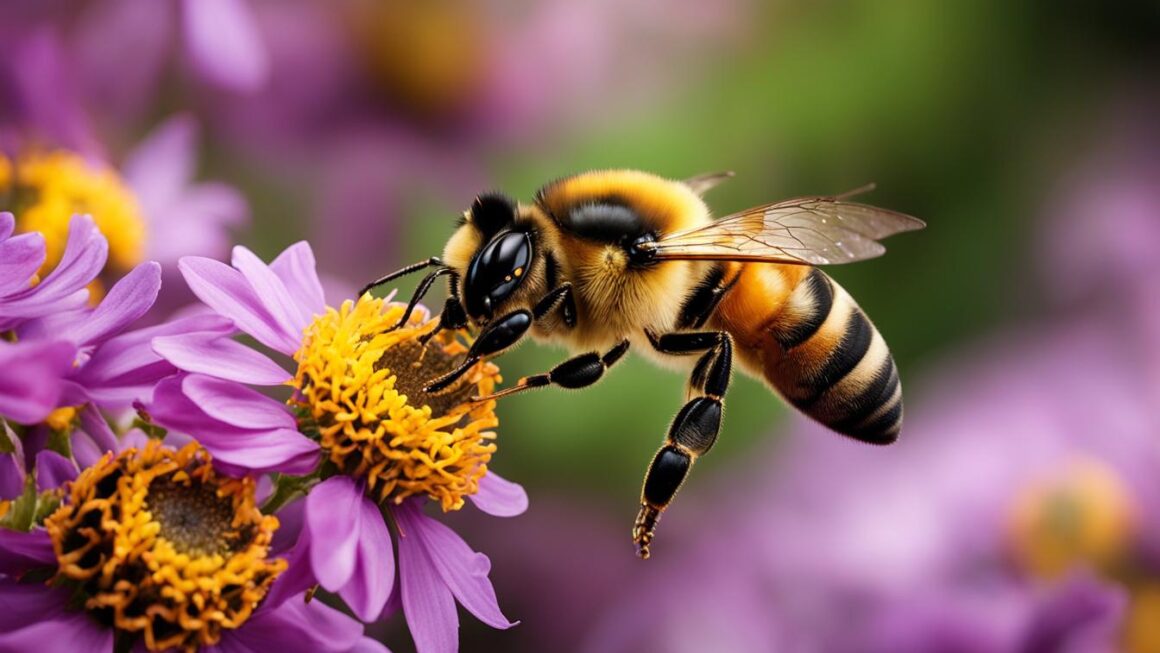You might know that honey bees dance to let each other know where to find the best flowers, but there’s so much more to learn about these important insects! Turn the pages to discover the difference between the queen bee and worker bees, and how honey bees actually make honey. Filled with simple science and plenty of animal facts, you can explore the fascinating world of a live queen bee and her kingdom.
Key Takeaways:
- A live queen bee plays a vital role in the hive’s reproductive success and population maintenance.
- Queen bees can be sourced from reputable suppliers who specialize in breeding high-quality queen bees.
- The life cycle of a queen bee includes mating flights and continuous egg-laying.
- Queen bee genetics influence the overall health and productivity of a hive.
- When starting or expanding a beekeeping operation, finding reliable sources for live queen bees is important.
The Role of the Queen Bee in a Hive
Within a bee colony, there is a single queen bee who is responsible for laying eggs and maintaining the population of the hive. The queen bee is the only sexually developed female in the colony and mates with drones to fertilize her eggs. Breeders focus on producing high-quality queen bees that exhibit desirable traits such as honey production and disease resistance. Beekeepers can source queen bees from reliable suppliers who specialize in breeding and providing these essential members of a hive.
Queen Bee Breeding
To ensure the production of high-quality queen bees, breeders carefully select mating partners and manage breeding colonies. They evaluate traits such as honey production, disease resistance, and temperament to ensure the best genetic characteristics are passed on. By breeding and selecting for desirable traits, breeders can enhance the overall health and productivity of bee colonies.
High-Quality Queen Bee Suppliers
Beekeepers rely on reputable suppliers who specialize in breeding high-quality queen bees. These suppliers have expertise in maintaining healthy breeding colonies and selecting strong genetic lines. By sourcing queen bees from reliable suppliers, beekeepers can introduce genetically superior bees into their colonies, improving overall hive health and productivity.
| Benefits of High-Quality Queen Bees | Characteristics |
|---|---|
| Promote Healthy Hive Growth | High egg production and genetic diversity |
| Increase Honey Production | Enhanced honey production traits |
| Improve Disease Resistance | Strong genetics for resistance to common bee diseases |
| Ensure Strong Colony Development | Positive genetic traits for overall colony strength |
By prioritizing the breeding and sourcing of high-quality queen bees, beekeepers can support healthy hive growth, increase honey production, improve disease resistance, and ensure the overall strength and productivity of their colonies.
“The queen bee is the heart of the hive, ensuring the vitality and productivity of the entire colony. Breeders and suppliers play a critical role in providing beekeepers with high-quality queen bees that possess the genetic traits necessary for a thriving hive.”
The Life Cycle of a Queen Bee
The life cycle of a queen bee is a fascinating journey that begins when she emerges from her wax cell as a virgin queen. During this stage, she is eager to embark on her mating flight, where she has the opportunity to mate with up to 20 drones. This process ensures genetic diversity within the colony, as each drone contributes to the queen’s offspring. Once mated, the queen bee returns to the hive and begins her vital role of laying eggs.
As the queen bee ages, her egg production gradually slows down. This natural decline in fertility can trigger a response from the worker bees, who sense the need to prepare for a new queen. They create a special cell and feed a chosen egg or larva with royal jelly, a nutritious substance that helps develop a new queen. This process is known as supersedure, and it ensures the continuity of the colony.
For beekeepers, maintaining the availability of live queen bees is crucial for the health and strength of their colonies. By understanding the life cycle of a queen bee and the timing of supersedure, beekeepers can intervene if necessary to prevent the loss of a queen and ensure the growth and productivity of their hives.
Table: Life Stages of a Queen Bee
| Stage | Description |
|---|---|
| Emergence | The queen bee emerges from her wax cell as a virgin queen. |
| Mating Flight | The queen bee mates with drones to ensure genetic diversity within the colony. |
| Egg Laying | The queen bee starts laying eggs and continues to do so throughout her life. |
| Supersedure | If the queen’s egg production declines, the worker bees create a new queen from an egg or larva. |
“The life cycle of a queen bee is a testament to the intricate balance and coordination within a bee colony. From her emergence as a young virgin queen to her vital role in sustaining the colony’s population, the queen’s journey is a captivating example of nature’s mastery. Understanding the life cycle of a queen bee is not only fascinating but also crucial for beekeepers seeking to maintain thriving and productive hives.”
The Importance of Queen Bee Genetics
Understanding the genetics of a queen bee is crucial for beekeepers who want to maintain healthy and productive colonies. The genetic makeup of a queen bee plays a significant role in determining various traits, such as productivity, disease resistance, temperament, and honey production. By selectively breeding queen bees with desirable genetic traits, beekeepers can ensure the success and stability of their hives.
Table: Queen Bee Genetic Traits
| Trait | Description |
|---|---|
| Productivity | A queen bee with favorable genetics can lay a large number of eggs, leading to a booming and thriving colony. |
| Disease Resistance | Queen bees with genetic resistance to common bee diseases can help protect the entire hive. |
| Temperament | Some queen bees exhibit calm and gentle behavior, making hive management easier for beekeepers. |
| Honey Production | Genetic factors can influence the amount and quality of honey produced by a hive. |
By prioritizing queen bee genetics, beekeepers can create colonies that are better adapted to their environment, healthier, and more productive. It is important to work with reputable suppliers who understand the importance of genetic diversity and breeding practices that promote desirable traits in queen bees.
The Impact of Genetics on Colony Dynamics
Queen bee genetics not only affect individual traits but also have a broader impact on the overall dynamics of a bee colony. A queen bee with favorable genetics can influence the behavior and productivity of worker bees. For example, a queen bee that lays a large number of eggs stimulates worker bees to perform tasks such as foraging, nest maintenance, and caring for the brood. On the other hand, a queen bee with unfavorable genetics may result in a less productive and less harmonious colony.
Finding Live Queen Bees for Your Beekeeping Endeavors
If you’re interested in starting or expanding your own beekeeping operation, you’ll need to find a reliable source for live queen bees. Many beekeepers offer queen bees for sale, either directly or through beekeeping supply stores. It’s important to research and choose reputable suppliers who prioritize the health and quality of their queen bees. They should provide information about the genetic background, breeding practices, and health status of the queen bees they offer.
When looking to buy live queen bees, consider reaching out to local beekeeping associations or clubs for recommendations. Experienced beekeepers can often provide valuable insights and suggestions for reputable suppliers in your area. Additionally, online forums and social media groups dedicated to beekeeping can be great resources for finding trusted sellers.
Before making a purchase, ask the queen bee supplier about their transportation and handling practices. Live queen bees are delicate and should be packaged and shipped with care to ensure their well-being upon arrival. It’s also important to inquire about any guarantees or warranties provided by the supplier in case of any issues with the queen bee.
Benefits of Buying Live Queen Bees
“Purchasing live queen bees offers several advantages for beekeepers. Firstly, it provides a convenient way to introduce new genetics into a hive, which can help improve desired traits and overall colony health. Secondly, a new queen bee can help strengthen a weak or underperforming colony by increasing egg production. Lastly, buying live queen bees allows beekeepers to replenish the queen bee population in their hives, ensuring the continued growth and productivity of their colonies.”
Table: Factors to Consider When Buying Live Queen Bees
| Factors | Considerations |
|---|---|
| Genetic Background | Look for suppliers who provide detailed information about the genetic traits and lineage of their queen bees. |
| Health Status | Ensure that the supplier conducts regular health checks and tests their queen bees for diseases or parasites. |
| Shipping and Handling | Inquire about the supplier’s shipping and handling practices to ensure the safe transportation of live queen bees. |
| Customer Reviews | Check online reviews and testimonials from other beekeepers who have purchased from the supplier to assess their reputation and customer satisfaction. |
By carefully selecting and purchasing live queen bees from reputable suppliers, beekeepers can ensure the health, genetic diversity, and productivity of their hives. Whether you’re a seasoned beekeeper or just starting out, buying live queen bees is an essential step in the journey of successful beekeeping.
The Art and Science of Beekeeping Queen Bees
Beekeeping queen bees requires a combination of art and science. Successful beekeepers understand the behavior and needs of queen bees, as well as the proper techniques for managing and introducing new queens to a hive. This delicate process ensures the health and productivity of the colony. Queen bees are critical to the overall success of a beekeeping operation, and their proper care and management can mean the difference between a thriving hive and a struggling one.
One essential aspect of beekeeping queen bees is understanding the process of “requeening.” This involves replacing an underperforming or aging queen with a new, more productive one. Beekeepers carefully assess the health and productivity of their existing queen, and if necessary, introduce a new queen to the hive. This process requires precision and attention to detail to ensure a smooth transition and minimize any disruption to the colony.
Beekeepers also focus on breeding queen bees with desirable genetic traits. By selectively breeding queens with traits such as high honey production, disease resistance, and calm temperament, beekeepers can create stronger and more productive colonies. This science-based approach to queen bee breeding helps to establish robust and resilient hives that can thrive in various environmental and agricultural conditions.
“The successful beekeeper combines their knowledge of bee behaviors with hands-on skills to create a harmonious relationship with their queen bees.” – Beekeeping expert
| Benefits of Proper Beekeeping Queen Bee Management | Challenges of Beekeeping Queen Bee Management |
|---|---|
|
|
Aspiring beekeepers should develop a deep understanding of the art and science of beekeeping queen bees. By honing their skills and knowledge, beekeepers can build and maintain healthy hives that contribute to the overall sustainability of bee populations and the essential role they play in pollination and ecosystem health.

The Fascinating Communication Systems of a Bee Colony
Bee colonies have intricate communication systems that allow the queen bee to coordinate the tasks and activities of the worker bees. Through chemical signals called pheromones, the queen bee can communicate specific instructions to her workers, such as the need for foraging, defending the hive, or caring for the young.
Worker bees, in turn, communicate with each other using dances and physical movements. These dances, known as “waggle dances,” convey information about the location and quality of food sources. By performing specific movements and patterns, worker bees can communicate the direction, distance, and even the type of flower to their fellow colony members.
This remarkable communication system ensures the efficiency and productivity of the hive. It allows the entire colony to work in harmony, with each bee knowing its role and responsibilities. The communication between the queen bee and the worker bees, as well as the communication between the worker bees themselves, is vital for the survival and success of the bee colony.
“The communication systems in bee colonies are truly fascinating. The ability of the queen bee to communicate through pheromones and guide the activities of the workers is extraordinary. And the dances performed by worker bees to share information about food sources are like a complex language. It’s a testament to the sophisticated social structure and cooperation within the hive.”
The Tasks and Communication in a Bee Colony
Within a bee colony, each bee has its own specific tasks, and communication plays a crucial role in organizing these tasks. For instance, worker bees communicate the need for new bees by constructing special cells and raising new queens from eggs or larvae. This initiation of a new queen is a highly coordinated effort that requires precise communication and collaboration among the worker bees.
The queen bee herself also communicates her reproductive status to the workers. Through her pheromones, she can signal to the workers whether she is fertile and actively laying eggs. This information allows the worker bees to adjust their behavior and tasks accordingly, ensuring the overall reproductive success of the hive.
The intricate communication systems of bee colonies are a true marvel of nature. By studying and understanding these systems, beekeepers can effectively manage and support the productivity of their colonies, ensuring the health and well-being of their queen bees and workers.
| Task | Communication Method |
|---|---|
| Foraging for food | Waggle dance and pheromones |
| Defending the hive | Pheromones |
| Caring for the young | Pheromones and physical contact |
| Constructing new cells | Physical movements and pheromones |
| Feeding the queen | Pheromones and physical contact |
Understanding the fascinating communication systems of bee colonies is key to appreciating the complex social structure and cooperation within a hive. It highlights the importance of communication in maintaining a healthy and productive bee colony and emphasizes the remarkable abilities of queen bees and worker bees to coordinate their tasks and ensure the survival and success of the entire colony.
The Hierarchy and Social Structure within a Bee Colony
Bee colonies have a well-defined social structure with a clear hierarchy. Each bee within the colony has specific roles and responsibilities that contribute to the overall functioning and productivity of the hive.
At the top of the hierarchy is the queen bee. She is the highest-ranked member of the colony and is responsible for reproduction and population maintenance. The queen bee mates with drones to fertilize her eggs and ensures the continuous growth of the hive.
Worker bees, which are sterile female bees, make up the majority of the colony. They perform various tasks such as foraging for food, building and maintaining the nest, nursing the brood, and regulating the hive temperature. Worker bees work diligently to support the overall survival and success of the colony.
The third type of bee within the colony is the male drone. Drones have the sole purpose of mating with the queen bee. They do not engage in any other tasks or responsibilities but are crucial for the reproductive cycle of the hive.
Overall, the hierarchy and social structure within a bee colony ensure that each bee has a specific role and contributes to the well-being and productivity of the hive as a whole.

The Hierarchy and Social Structure within a Bee Colony
Within a bee colony, a well-defined social structure exists, with a clear hierarchy determining the roles and responsibilities of each individual bee. Let’s explore the different members of the colony and their contributions:
- Queen Bee: At the top of the hierarchy is the queen bee, the only sexually developed female in the colony. Her primary role is reproduction, as she lays eggs and ensures the continuity of the population.
- Worker Bees: The majority of the colony consists of worker bees, sterile females who perform various tasks essential for hive functioning. These tasks include foraging, nest maintenance, nursing the brood, and regulating temperature.
- Drones: Male drones make up a small percentage of the colony. Their sole purpose is to mate with the queen bee to fertilize her eggs.
This hierarchical structure enables efficient division of labor and ensures the survival and productivity of the hive. Each bee has a specific role that contributes to the overall well-being of the colony.
Understanding the hierarchy and social structure within a bee colony is crucial for beekeepers and researchers to effectively manage and support the health and productivity of their hives.
The Conservation Challenges Faced by Queen Bees
Queen bees, like all bees, face significant conservation challenges in today’s world. Climate change and the use of insecticides pose threats to their survival and the overall health of bee populations. These challenges require urgent attention and action from beekeepers, conservationists, and policymakers.
The Impact of Climate Change
Climate change has a direct impact on the availability of food sources for queen bees and their colonies. Rising temperatures and altered flowering patterns can disrupt the synchrony between bees and their preferred nectar and pollen sources. This negatively affects the nutrition and overall health of queen bees, making them more vulnerable to diseases, pests, and other stressors.
Additionally, climate change can lead to changes in habitat suitability and availability, forcing bees to migrate to new areas or face habitat loss. This displacement can further exacerbate the challenges faced by queen bees and their ability to establish and maintain thriving colonies.
The Threat of Insecticides
Insecticides, especially neonicotinoids, have been linked to detrimental effects on bee health and behavior. These chemicals can be found in agricultural practices and are used to control pests. Unfortunately, they can also harm non-target organisms, including queen bees and other beneficial insects.
Exposure to insecticides can weaken queen bees’ immune systems, impair their reproductive abilities, and disrupt their navigation and foraging behaviors. This can result in reduced egg production, decreased genetic diversity, and overall colony decline. Minimizing the use of harmful insecticides and implementing sustainable pest management practices are essential for the conservation of queen bees and the preservation of healthy bee populations.
Conclusion
Protecting and supporting queen bees is crucial for the conservation of bee populations and the ecological balance they uphold. Addressing the challenges of climate change and reducing the use of harmful insecticides are fundamental steps toward ensuring the survival and well-being of queen bees. By prioritizing sustainable beekeeping practices, habitat preservation, and raising awareness about the importance of these vital pollinators, we can contribute to the conservation of queen bees and the preservation of our ecosystems.
Conclusion
The world of a live queen bee and her kingdom is a captivating and intricate ecosystem. The roles, behaviors, and genetics of queen bees are crucial for beekeepers and conservationists. Breeding and sourcing live queen bees play a significant role in maintaining healthy hives and productive colonies.
For aspiring beekeepers, finding reliable sources to buy live queen bees is essential. Researching reputable suppliers who prioritize the quality and health of their queen bees is crucial. These suppliers should provide information about the genetic background, breeding practices, and health status of the queen bees they offer.
By understanding and supporting the communication and social structures of queen bees, beekeepers can manage and enhance the productivity of their colonies. The conservation challenges faced by queen bees, such as climate change and the use of insecticides, require the collective efforts of beekeepers and conservationists to protect their survival and contribute to the sustainability of bee populations.
Overall, prioritizing the well-being and conservation of live queen bees is vital for maintaining the viability and valuable contributions of these essential insects to our environment.
FAQ
What is the role of the queen bee in a hive?
The queen bee is responsible for laying eggs and maintaining the population of the hive. She is the only sexually developed female in the colony and mates with drones to fertilize her eggs.
How do I find high-quality queen bees for my beekeeping operation?
You can source queen bees from reliable suppliers who specialize in breeding and providing these essential members of a hive. It’s important to choose reputable suppliers who prioritize the health and quality of their queen bees.
What is the life cycle of a queen bee?
The life cycle of a queen bee begins when she emerges from her wax cell as a virgin queen. She then mates with drones during a mating flight and returns to the hive to lay eggs throughout her life.
How important are queen bee genetics?
Queen bee genetics play a vital role in the success and productivity of a hive. Favorable genetics can contribute to traits such as productivity, disease resistance, temperament, and honey production.
Where can I find live queen bees for sale?
Many beekeepers offer queen bees for sale, either directly or through beekeeping supply stores. It’s important to research and choose reputable suppliers who provide information about the genetic background and health status of the queen bees.
What is involved in beekeeping queen bees?
Beekeeping queen bees requires understanding their behavior and needs, as well as the proper techniques for introducing new queens to a hive. Beekeepers may engage in techniques such as “requeening” to replace underperforming or aging queens with more productive ones.
How do bees communicate within a colony?
Bees utilize chemical signals called pheromones and physical movements such as dances to communicate within a colony. The queen bee uses pheromones to give specific instructions, while worker bees use dances to share information about food sources and locations.
What is the social structure within a bee colony?
Bee colonies have a well-defined social structure with a clear hierarchy. The queen bee is the highest-ranked member responsible for reproduction, while worker bees perform various tasks, and male drones mate with the queen.
What conservation challenges do queen bees face?
Queen bees, like the entire bee population, face challenges from climate change and the use of insecticides. Changes in temperature and altered flowering patterns can disrupt their food sources, while insecticides can have harmful effects on their health and behavior.
How can I support the conservation of queen bees?
Supporting the conservation of queen bees involves prioritizing their well-being and taking steps to ensure the sustainability of bee populations. This can include practicing sustainable beekeeping methods and advocating for pollinator-friendly policies and practices.




